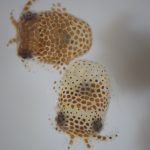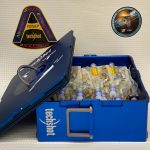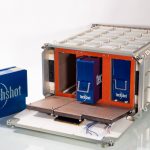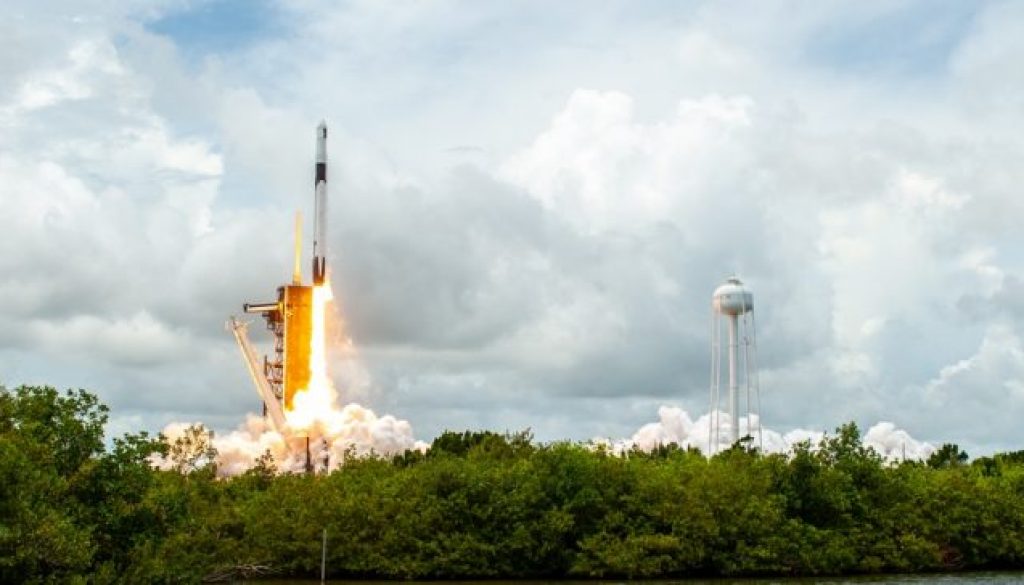Hawaiian Stowaways
Say Hi to Euprymna scolopes
The special passenger on the officially uncrewed Commercial Resupply Mission SpX-22 I want you to meet today bears the official name of Euprymna scolopes, but is known as Hawaiian bobtail squid to friends. When it’s not going to space in the name of science, it mostly lives in the shallow coastal waters off the Hawaiian Islands and Midway Island – so it’s a native of the central Pacific Ocean.
Bobtail squids have eight suckered arms and two tentacles. Like cuttlefish, they can swim by either using the fins on their mantle or by jet propulsion. They come in different types and sizes, but they are generally quite small creatures. The ones that went up to space grow up to 30 mm in mantle length (the mantle is the main body of the squid). When they hatch, they weigh about 0.0005 g. Adults weigh up to 2.67 g.
So they are tiny and look cute. But why send them to space? Because these little ones have a relationship going that has made them interesting to scientists studying the beneficial interaction between animals and microbes. Bobtail squids are hunters, in the wild they feed on shrimps. And they let bacteria live in their mantle to turn them into stealth predators.
Bugs for stealth
Hawaiian bobtail squid have a symbiotic relationship with bioluminescent bacteria Aliivibrio fischeri. The squid provide them with their own place to live in a special organ in their mantle, feed them sugar and an amino acid solution. In return, the bacteria glow, which hides the squid from their prey when viewed from below, as the bioluminescence matches the sunlight from above.

These helpful bacteria obviously have to come from somewhere. Luckily, they live abundantly in sea water. So once the squid has hatched, it will start ventilating ambient seawater through its mantle cavity. Each ventilation round of about 2.6 ml of seawater will bring a single A. fischeri cell into the organ. The squid will do this about every second, so this and happy, multiplying bacteria being fed sugar will build up the number and fill the crypt space within about 10 – 12 hours after hatching.
This fairly well understood process has turned out to be a great model for the way animals and bacteria work together for mutual benefit. And we humans also depend on bacterial services for many tasks. There are more than 2000 identified bacterial species that form associations with humans. In our gut, for example, bacteria help us by synthesizing certain vitamins. Like squid we acquire our little helpers after birth (or some of apparently during birth). So there’s a lot we can learn from Hawaiian bobtail squid. But why send them to space?
Why Space?
We know that our symbiotic relationship with certain microbes, our microbiome, is important for our wellbeing. And we also know that microgravity has an impact on animal-microbial interaction. While most research into that has focused on the fewer than 100 species identified as human pathogens, it is necessary to conduct studies that care about the beneficial animal – microbial interactions.

Now it is time to meet our second hero: Jamie S. Foster, Ph.D.. She is a Professor in the Department of Microbiology and Cell Science at the University of Florida and Principal Investigator of the ADSEP-UMAMI experiment (Understanding of Microgravity on Animal-Microbe Interactions). Her research is all about understanding how microbes interact with each other and their surrounding environment. And as Microbes play a significant role in the normal development of animal tissues, one of her lab’s research projects examines the effects of microgravity on the normal developmental interactions between an animal host and a bacterial symbiont. For that, Euprymna scolopes and its support, the luminescent bacterium Vibrio fischeri, are a great model.
Jamie Foster has been working with the bobtail squid for 28 years now, she noted. And she actually had them flying in space before. A small pilot experiment was flown on STS-134 – the penultimate shuttle mission, and again on the final mission of the Space Shuttle, STS-135. She has a page on her lab’s site that has a lovely short film on these missions.
And now, squids got to fly again – this time on the SpaceX Dragon.
But how?

Dr. Foster and her team want to study the effect of microgravity on the molecular and chemical interactions between beneficial microbes and their animal hosts. They do that by looking at how the lack of gravity impacts how the bobtail squid initially acquire their beneficial microbial partners after hatching.
So the trick is to get newly hatched bobtail squid into space and then slowly introduce them to the microbes. When launched, they are in a state called paralarvae, which indicates that they have hatched, but are not yet adults. They live in the ADvanced Space Experiment Processor (ADSEP) hardware provided by Techshot, a company providing turnkey spaceflight equipment development and flight integration services. The ASEP automatically initiates and terminates the experiments aboard the Dragon spacecraft once it has docked with the International Space Station (ISS).

The ADSEP has two Fluid Processing Cassettes (FPC) with about 8 culture bags, each containing up to eight paralarvae. The paralarvae in one cassette, called the SYM cassette, are inoculated with filtered seawater containing 10,000 cells/mL of the symbiotic V. fischeri and incubated for 12 hours. The second is called the APO cassette, because the paralarvae in this one are inoculated with filtered seawater without bacteria to maintain an aposymbiotic control, i.e. a population without microbes. To get a timeline, experiments in both cassettes have RNAlater injected into the bags to terminate the experiment and euthanize the paralarvae at 0 hours, 2 hours, 6 hours, and 12 hours post-inoculation.
Once this has happened, the crew transfers the RNALater-preserved samples to -80°C cold stowage until return to Earth.
Flight Home
CRS-22 launched on June 3rd, 2021, which means at the time of writing, the squid are probably already frozen. The mission is expected to last until July 6th, when the Dragon will undock and return to earth. The ISS is a quite popular place at the moment and docking may become scarce sooner rather than later. As of June 5th, 2021, five spaceships were attached to the space station: the SpaceX Crew Dragon and Cargo Dragon spaceships, the Northrop Grumman Cygnus cargo craft, and Russia’s Soyuz MS-18 crew ship and ISS Progress 77 resupply ship. And on June 30th, the Progress 78 resupply ship has launched from Baikonur.
The preserved samples are returned to Earth aboard the SpaceX Dragon spacecraft (along with the FPC/ADSEP hardware) in an ISS cold stowage asset at -20°C. After splashdown in the Atlantic Ocean near the eastern coast of Florida, the sample bags are stored at -80°C freezer until the people from Techshot collect the samples and deliver them to Dr. Foster at the Space Life Science Lab at the Kennedy Space Center (KSC).
Here, the preserved tissues will be examined at the molecular level to examine how the transcriptome, or all the genes expressed at a given moment, have changed in the space environment under the presence or absence of their symbiotic bacteria. Yet another step in our understanding how these beautifully complex systems called animals behave under those conditions they have not evolved for.

